
F/A-18E Super Hornets attached to the Royal Maces of Strike Fighter Squadron 27 conduct a fly-by ... [+]
U.S. Navy photo by Mass Communication Specialist 2nd Class Samantha JetzerThe U.S. Navy quietly has stood up a program office to begin figuring out what the sailing branch needs in a new manned fighter jet.
One leading Washington, D.C. think tank has ideas. Whatever the Navy buys to replace today’s F/A-18E/F Super Hornet, it should “emphasize range and speed, with low-observability being a secondary concern.”
In other words, it need not be a stealth fighter. Not as long as it can fly far and fast while carrying a useful payload.
The Navy’s current warplanes are likely to hang around through the 2030s. The fleet’s nine carrier air wings at present possess around 70 planes—44 F/A-18E/Fs, five EA-18G jamming planes, five E-2 radar planes, a pair of C-2 transports and around 19 H-60 helicopters.
New CVM-22B tiltrotors are replacing the C-2s and MQ-25 tanker drones are due to arrive in the mid-2020s. A single squadron of around 10 F-35C stealth fighters eventually will replace one unit of Super Hornet in each wing.
The Navy wants the new Next-Generation Air-Dominance plane, or F/A-XX, to be ready in time to replenish the remaining Super Hornet squadrons once the newer F/A-18E/Fs start wearing out in the 2030s.
To that end, Naval Air Systems Command this year established the NGAD office. The program it oversees could end up spending nearly $70 billion through the 2050s to buy potentially hundreds of new fighters. Today there are around 600 F/A-18s in the Navy inventory.
The Navy hasn’t specified exactly what it wants the F/A-XX to do. But the Center for Strategic and Budgetary Assessments in Washington, D.C. has ideas. The fleet “will require carrier-based aircraft with the ability to intercept enemy aircraft or cruise missiles and engage them with either [air-to-air missiles] or directed-energy weapons.”

An F-14 tests a Phoenix air-to-air missile in 2002.
U.S. Navy photo by Capt. Dana PottsDrones that can loiter for long periods of time, waiting for enemy forces to fly into their sensor- and weapons-range, could handle some counter-air missions. But two missions probably require a fast, manned fighter—self-escort and offensive counter-air.
CSBA assumes that defeating numerically-superior Chinese or Russian forces will require Navy warplanes to employ large numbers of munitions. “To achieve larger salvos, attack aircraft will need to approach targets more closely where they can use smaller, shorter-range weapons.”
The problem is, at short range the attacking planes are likely to run headlong into “a dense array of overlapping radars and passive sensors that would challenge the low-observability features incorporated into today’s strike-fighters and bombers.”
In other words, emphasizing stealth at the expense of other qualities probably is a bad idea.
Instead, the Navy’s new fighter should be fast and maneuverable while also possessing a combat radius that’s sufficient to keep the carrier beyond the range of the deadliest enemy anti-ship weapons—1,000 miles or so, seems to be the consensus. That’s 400 miles farther than an F/A-18 or F-35 can travel with a useful weapons load and moderate refueling support.
To help it defend itself, the Navy should equip the new fighter with “sensor-countermeasures”—that is, jammers—and self-defense weapons such as anti-missile missiles and lasers, CSBA recommended.
The Navy reportedly already has decided its new fighter will be a brand-new design rather than a derivative of the F/A-18 or F-35. If the service follows CSBA’s advice, its future F/A-XX could look a lot different than the non-stealthy and short-range F/A-18 and stealthy and short-range F-35 do.
Indeed, a fast, long-legged and reasonably maneuverable next-gen fighter could end up looking a lot like the Navy’s last fast, long-legged and reasonably maneuverable fighter did.
We’re speaking, of course, of the legendary F-14.
The Link LonkAugust 22, 2020 at 07:00PM
https://www.forbes.com/sites/davidaxe/2020/08/22/forget-stealth-the-us-navys-new-fighter-could-look-like-the-old-f-14/
Forget Stealth—The U.S. Navy’s New Fighter Could Look Like The Old F-14 - Forbes
https://news.google.com/search?q=forget&hl=en-US&gl=US&ceid=US:en

No comments:
Post a Comment